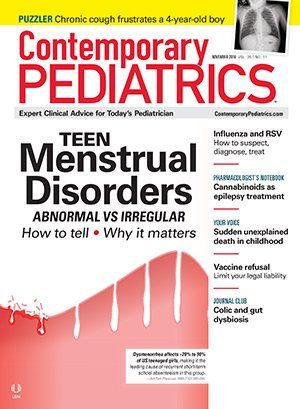CDC: Teens missing the nutritional mark
For teenagers’ developing minds and bodies, good food and activity choices are key to appropriate development. A new survey from the Centers for Disease Control and Prevention reveals trends that check how US teenagers are doing.
Kathleen Ethier, PhD

Teenagers are often found facing a screen-whether it’s a phone, television, computer, or video game. Although digital media has some benefits, the extent to which children and adolescents rely on media is highlighted in a new report that studies common healthy-and unhealthy-behaviors in young persons today.
Data on digital media use and other health activity trends, such as nutritional choices and physical activity, among children and teenagers were unveiled earlier this year in the newest Youth Risk Behavior Survey (YRBS)1 from the Centers for Disease Control and Prevention (CDC). The survey identifies health-related behaviors and trends across 6 categories every 2 years to compile a national report assessing adolescent health risks.
The report monitors 6 categories of health-related behaviors among adolescents and young adults: behaviors that contribute to unintentional injuries and violence; tobacco use; alcohol and other drug use; sexual behaviors related to unintended pregnancy and sexually transmitted infections (STIs), including human immunodeficiency virus (HIV) infection; unhealthy dietary behaviors; and physical inactivity.
The entire report summarizes a total of 121 health-related behaviors of students across 39 states. Contemporary Pediatrics previously covered the report’s findings on alcohol and drug use, sexual behaviors, and other high-risk behaviors.2 This report will focus on dietary behaviors and physical activity trends.
According to the CDC, 43% of the students studied in the report played video or computer games, or used a computer for 3 or more hours each day-above the previously estimated 2 hours per day. The report points out that this usage increased from 22.1% to the current 43% between 2003 and 2017. This computer time happens on school days, but doesn’t necessarily involve the completion of school work, according to the report, and 15.4% of the teenagers studied were sedentary for at least an hour in the prior week that they were polled. The report adds that 14.8% of the teenagers polled were obese and 15.6% were overweight.
Adolescents also reported high rates of television use, with 20.7% watching 3 or more hours of television daily-although this rate was a decline from 42.8% in 1999.
The CDC reveals in a statement about the report findings that whereas physical activity is one of the most proactive things individuals can do for their health, children and teenagers are falling short in this category.
“American youth do not get the recommended amount of physical activity nor do they eat the recommended amounts of fruits and vegetables each day,” according to the CDC. “Regular physical activity can help children and adolescents improve cardiorespiratory fitness, build strong bones and muscles, control weight, reduce symptoms of anxiety and depression, and reduce the risk of developing health conditions such as heart disease, cancer, type 2 diabetes, high blood pressure, osteoporosis, and obesity,” the researchers write.
Some trends were promising, however, with nearly half-46.5%-of students reporting that they were active for at least an hour each day on 5 or more days during the week prior to the survey, and 26.1% of teenagers were active for at least an hour every day of the week. Additionally, 51.1% did strength or toning exercises at least 3 days each week, according to the report.
Physical education (PE) classes in school offer some motivation as well, with 51.7% of students attending PE classes at least 1 day a week at school, and about a third of students attending PE classes daily. Participation on sporting teams also remains popular, with 54.3% of students playing on at least 1 sports team through school or another organization.
In addition to regular physical activity, the CDC also recommends that children and adolescents eat 1 to 2 cups of fresh fruit and 1 to 3 cups of fresh vegetables daily. The report found, however, that 5.6% of teenagers had not eaten fresh fruit or drunk 100% fruit juice in the week prior to the survey. Another 60.8% had fruit or fruit juice at least once per day; 31.3% had 2 or more servings of fruit or fruit juice daily; and 18.8% had 3 or more servings of fruit or fruit juice daily in the week before the survey.
Rates of vegetable consumption were similar, with 7.2% not eating any fresh vegetables in the week before the survey. About 60% of teenagers had at least 1 serving of vegetables per day; 26.6% had 2 or more servings per day; and 13.9% had 3 or more servings per day in the week before the survey.
Aside from fresh fruits and vegetables, the survey found that milk consumption was also low, with 26.7% of teenagers not consuming any milk in the week before the survey. About 31% consumed at least 1 glass of milk daily; 17.5% had at least 2 glasses per day; and 7.9% drank at least 3 glasses of milk daily. On the positive side, roughly a third-27.8%-did not consume soda or pop in the week before the survey; 18.7% drank soda at least once a day; 12.5% drank 2 or more servings per day; and 7.1% drank 3 or more servings per day.
Most students also avoided sports drinks, according to the report, with 47.7% of students avoiding all sports drinks in the week prior to the survey. Water appeared to be the favored drink, with 51.3% of teenagers drinking 3 or more glasses or bottles of water daily. Almost 67% drank at least 2 servings of water daily; 75.4% drank at least 1 serving; and just 3.8% of teenagers reported not drinking any plain water at all in the week prior to the survey.
In terms of eating habits, the survey found that 14.1% of adolescents skip breakfast daily, whereas 35.3% eat breakfast every day, according to the report.
Other health issues addressed in the survey were the prevalence of certain conditions, such as asthma. The report notes that 22.5% of students had been told by a clinician that they had asthma, an increase from 18.9% in 2003.
The report also reviewed dental care, revealing that 1.5% of teenagers had never seen a dentist whereas 75.7% had been to a dentist in the year prior to the survey. Tanning bed use also was reviewed, with indoor tanning decreasing from 15.6% in 2009 to just 5.6% in 2017, according to the report. Still, exposure is a concern, with 57.2% of teenagers reporting 1 or more sunburns in the prior year whether from outdoor sun exposure or indoor tanning use.
Sleep was another concern addressed in the report. The CDC found that 25.4% of students got 8 or more hours of sleep on school nights, with levels of sleep decreasing as teenagers progressed through their high school years.\
Kathleen Ethier, PhD, director of the Division of Adolescent and School Health for the CDC, says that overall this year’s report shows that adolescents are generally making better decisions about their health and the risks they take, but there is also more work to be done. Pediatricians are in a unique position to offer guidance on healthy food and activity choices, she says, as well as to offer education and support for preventive care. These efforts should be in conjunction with school and community programs, as well as family support, she says.
“Connectedness is key to protecting health of adolescents-to family, to peers, and to important adults in their schools and other community organizations, including their healthcare providers,” Ethier says. “Students are more likely to thrive if they know they matter-that they have adults, teachers, and friends who care about their safety and success-and these protections last into adulthood.”
References:
1, Kann L, McManus T, Harris WA, et al. Youth Risk Behavior Surveillance-United States, 2017. MMWR Surveill Summ. 2018;67(8):1-114. Available at: https://www.cdc.gov/mmwr/volumes/67/ss/ss6708a1.htm?s_cid=ss6708a1_w. Accessed August 28, 2018.
2. Zimlich RZ. CDC examines risky teen behavior. Contemporary Pediatrics.com. Available at: http://www.contemporarypediatrics.com/adolescent-medicine/cdc-examines-risky-teen-behavior. Published August 7, 2018. Accessed August 28, 2018.

Having "the talk" with teen patients
June 17th 2022A visit with a pediatric clinician is an ideal time to ensure that a teenager knows the correct information, has the opportunity to make certain contraceptive choices, and instill the knowledge that the pediatric office is a safe place to come for help.
Meet the Board: Vivian P. Hernandez-Trujillo, MD, FAAP, FAAAAI, FACAAI
May 20th 2022Contemporary Pediatrics sat down with one of our newest editorial advisory board members: Vivian P. Hernandez-Trujillo, MD, FAAP, FAAAAI, FACAAI to discuss what led to her career in medicine and what she thinks the future holds for pediatrics.